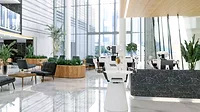5 AI Trends You Should Be Using to Improve Physical Security

From navigational software to advanced analytics, artificial intelligence-based technology is being used in many capacities for security, and as this smarter technology becomes more mainstream, its use will only grow. We've seen AI usage in diagnostic applications within the healthcare industry and in the emergence of self-driving cars, and with the growth experienced in these areas, it’s become hard to avoid AI’s massive implications around the world.
AI can be roughly divided into two categories: general and narrow. General AI can enable machines to perform tasks at and beyond the quality of general human performance. But when it comes to security, the technology being developed falls under the category of narrow AI: focusing on executing certain defined tasks, such as object recognition in the case of video analytics or navigation for a security robot. Here are five AI trends emerging in both the security industry (and beyond) that you should be using:
Advanced Video Analytics
Video analytics is one of the first major domains within the security industry that is being radically transformed by AI – and this is already in practice in many organizations today. AI eliminates the need for pre-programmed algorithms, allowing sensor technology available today to capture an incredible amount of metadata in real time. AI enables video analytics to do much more than just alert users when a person or object has crossed a barrier; now, large organizations with thousands of security cameras can specifically identify a person approaching through facial recognition software, for example. Camera technology running analytics can also quickly and efficiently scan approaching vehicles and their license plates. This information can be cross-referenced with persons of interest to alert security teams if a threat has the potential to occur.
Operational Efficiency
AI across the board is quickly shifting from an underlying technology capability to being used as a fundamental tool for daily engagement with people – both customers and employees. Smart security solutions, such as video management systems or networked access control and visitor management, now can take the data being collected and correlate it with patterns in behavior for employees and visitors to a facility. This data, in turn, can be used to find ways that an organization can increase efficiencies and save valuable resources. For example, access control information can be used to evaluate when facilities are not in use so that energy usage can be decreased.
IoT
The Internet of Things (IoT) is a term that gets thrown around a lot, but what it means is that there are a number of devices that are capable of talking to each other on a network; everything from mobile phones to your refrigerator can be connected (really, anything with an on/off switch). As the expansion of sensors and devices through the IoT are used in an organization, including from security-related devices, the sheer volume of data being created will increase at a rapid pace, requiring AI-enabled software and machine learning to take that information and pinpoint what is really meaningful. For example, some facilities are implementing wearable devices for employees that can also learn habits and create patterns based on usage. This may sound like science fiction, but this really is emerging as next-level tech in the security world.
Robotics
As for security robots, AI is the driver of the two main technologies that security robots leverage, be it unmanned ground vehicles (UGVs) or unmanned aerial vehicles (UAVs), more commonly known as drones. AI makes it possible to augment traditional security officers through integrated robotic systems, leveraging advanced navigation capabilities, obstacle avoidance sensors and intelligent mechanics to streamline operations and reduce the risk of human injury in dangerous environments.
Decision-Making
AI technology already permeates our world at home; think of how many times a day you ask Siri for information, ask Alexa to add items to your to-do list or let Google know you're on your way home so it can cool down the house for you. We aren't too far away from this technology being used on a day-to-day basis to help security officials make split-second decisions in the event of an incident. AI-enabled technology has the potential to take the guesswork out of answering alarms by determining which events require a call to law enforcement and which are false alarms. While much of this technology is still in prototypes, the potential is real.
It’s clear that AI provides end users and security professionals with a wealth of advantages when it comes to increasing operational efficiencies, proactively identifying risks and ensuring informed, rapid responses to security incidents. While nothing can substitute human-to-human interaction, combining AI-enhanced technology with traditional security measures can radically improve functionality and help organizations reach their security goals.
Looking for a reprint of this article?
From high-res PDFs to custom plaques, order your copy today!






